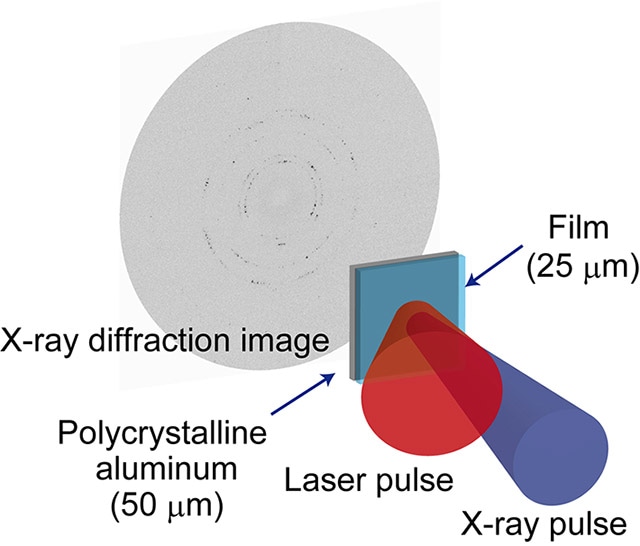Jun 24 2019
Understanding the way shock waves influence structures is critical for the progress of material science research, including safety procedures and unique surface alterations. Using X-ray diffraction probes, researchers at the Institute of Materials Structure Science of KEK, Tokyo Institute of Tech, Kumamoto University, and the University of Tsukuba explored the deformation of polycrystalline aluminum foil when exposed to a laser-driven shock wave.
 Diffraction patterns of deformed crystals - Aluminum foil irradiated by a laser-driven shock wave is followed by an X-ray pulse to read the diffraction pattern of the crystal structure. (Image credit: Tokyo Institute of Technology)
Diffraction patterns of deformed crystals - Aluminum foil irradiated by a laser-driven shock wave is followed by an X-ray pulse to read the diffraction pattern of the crystal structure. (Image credit: Tokyo Institute of Technology)
Engineering is founded on the understanding and manipulation of the structure of materials to harness their properties in novel ways. Interactions between materials happen via the exchange of forces so envisaging a material's ability to endure a force and how it propagates is key to creating structures with better strength.
If a sudden strong force aimed at a material results in a shock wave, the atoms may become dislocated or displaced. Similar to a rubber band, if the external force is not too momentous, the internal forces can resist and the material can return to its former state (elastic deformation). But past a specific limit, the force may result in permanent damage or even structural failure (plastic deformation) of the material.
Unit cells are the smallest commonly repeating 3D atomic structure that reflects the whole symmetry of a crystal, and examining their displacement can offer deep insights. However, monitoring processes at the atomic scale is very hard. X-ray diffraction can be used to overcome this issue. Visualize a camera that allows users to capture events occurring at the atomic scale.
When an X-ray bumps into an atom, it gets absorbed and then re-released by the atom. This results in the wave being diffracted or scattered in an orderly manner, due to the orderly set up of atoms in the crystal.
According to the spatial arrangement, size, and distance between the atoms, the wave is scattered in various directions with varying intensities. Therefore, the atomic structure is trapped as signals, like a photograph of the crystal during and after the shock wave passes. This can be utilized to decipher crystal deformation.
Encouraged by this, scientists performed an experiment to track the deformation process of polycrystalline aluminum foil when exposed to a laser-triggered shock wave. This disruption was then captured as diffraction spots of an X-ray beam which could be concurrently compared to the diffraction pattern of the pre-shock crystal. They learned that large grains of aluminum were rotated, compressed elastically, and decreased in size along the wave direction.
As the wave spread deeper into the sample, the diffraction spots smoothed and widened, and the original diffraction spots started to vanish, replaced by a new bunch of spots.
We observed grain refinement and structural changes of the polycrystalline metal, which increased with the propagation of the laser-driven shock wave. This, in turn, enabled the study of microstructural deformation in plastic shock flows from the atomic to the mesoscale level.
Dr. Kohei Ichiyanagi, High Energy Accelerator Research Organization and Jichi Medical University
Modern research of post-shock structural variations of materials frequently fails to emphasize the process of wave dissipation and the distribution of flaws. This research alters the status quo by offering a technique to track grain refinement and structural variations, including surface hardness and alteration, of polycrystalline metal during shock wave loading.
Hopeful about the prospect of this research, Professor Kazutaka G. Nakamura of the Tokyo Institute of Technology said, "Our technique will be valuable for revealing mechanisms of microstructural change for various alloys and ceramics based on dynamic processes."
Assuredly, this reveals the creative ways scientists can expand the boundaries of what they are able to view: in this case, it is how X-rays can be used to capture the way particles are shaken and stirred.